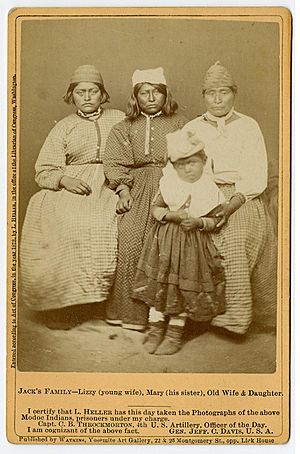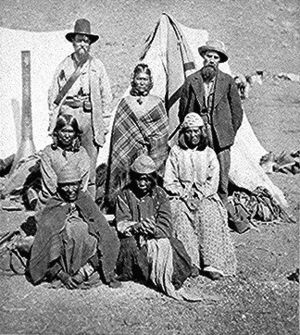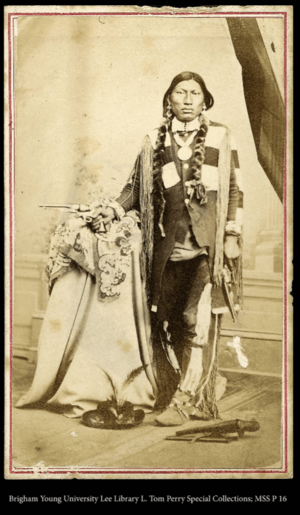Kintpuash facts for kids
Quick facts for kids
Kintpuash
"Captain Jack" |
|
|---|---|
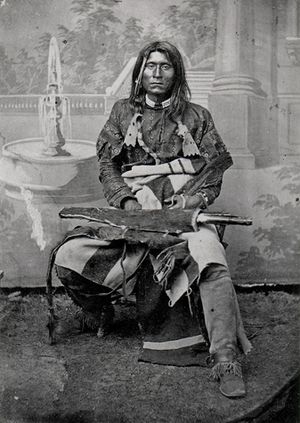
Kintpuash in 1864
|
|
| Chief, Modoc people | |
| Personal details | |
| Born | c. 1837 Tule Lake area, California |
| Died | October 3, 1873 (aged 35–36) Fort Klamath, Oregon |
| Cause of death | Execution by hanging |
| Military service | |
| Battles/wars | Modoc War |
Kintpuash, also known as Captain Jack, was an important leader of the Modoc tribe. He was born around 1837 near Tule Lake in California. His Modoc name meant 'Strikes the water brashly.'
Kintpuash led his people during a difficult time. They wanted to live on their traditional lands. From 1872 to 1873, he led a small group of Modoc warriors. They defended their land against the United States Army in the Modoc War.
Kintpuash was later executed by the Army. This happened after a peace meeting where General Edward Canby and Reverend Eleazar Thomas were killed.
Contents
Early Life of Kintpuash
Kintpuash was born about 1837. His family lived in their ancestral Modoc territory. This land was near Tule Lake, close to what is now the California-Oregon border. The Modoc people had lived there for a very long time.
In 1864, white settlers wanted the Modoc's fertile land. The United States government forced Kintpuash and his family to move. They were sent to the Klamath Reservation in Oregon. This reservation was mainly home to the Klamath people, who were rivals of the Modoc. The Modoc felt they were treated poorly there.
In 1865, Kintpuash became known as Captain Jack to the American settlers. He led a group of Modoc people away from the reservation. They returned to their home near Tule Lake in California.
The United States Army brought them back to the Klamath Reservation in 1869. But conditions had not improved for the Modoc. So, in April 1870, Captain Jack led about 180 Modoc people back to the Tule Lake area again.
The Modoc War: A Fight for Land
In 1872, the US Army tried to force Captain Jack's group back to the reservation. On November 29, a fight broke out during surrender talks. This happened at the Lost River in Oregon. It led to the Battle of Lost River.
Kintpuash and his group escaped into an area called the Lava Beds National Monument. This place was like a natural fort. It had many caves and trenches made of lava. These were perfect for defense. Women and children could also hide safely there.
On January 17, 1873, the Army attacked the Modoc in the lava beds. The Army lost 35 soldiers and many were hurt. The Modoc had no casualties at all.
Kintpuash wanted a peaceful solution. He hoped his people could stay on their land. His advisers thought that if they killed the Army's leader, the Army would leave.
He began talking with a federal peace group. During these talks, some Modoc warriors pushed for a stronger approach. Kintpuash agreed to their plan. He called for another meeting with the peace group.
On April 11, at this meeting, Kintpuash and other Modoc warriors drew their pistols. Kintpuash shot General Edward Canby. Another Modoc warrior, Boston Charley, killed Reverend Eleazar Thomas. Two other people were wounded. The Modoc then fled back to the lava beds.
General Canby was the only general killed during the American Indian Wars. After this event, General Jefferson C. Davis took over. He brought more than 1000 soldiers. He was determined to end the Modoc resistance. On April 14, the Army attacked the lava stronghold again. Many Modoc scattered to avoid being captured.
Surrender and Execution
Over the next few months, some Modoc groups continued to fight. Others began to surrender to the Army. Kintpuash managed to avoid capture for a while.
However, some Modoc men agreed to help the Army find him. These men included Hooker Jim and Boston Charley. On June 1, Kintpuash surrendered. He laid down his rifle as a sign of surrender.
He was taken to Fort Klamath. Kintpuash was tried by a military court. He was found responsible for the deaths at the peace meeting. On October 3, 1873, Kintpuash was executed by hanging. Three other Modoc warriors, Black Jim, John Schonchin, and Boston Charley, were also executed with him. Some other warriors were sent to prison.
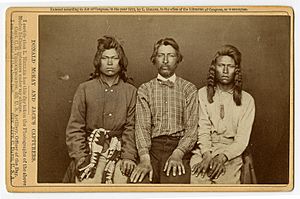
Legacy
- The area where the Modoc defended themselves is now called Captain Jack's Stronghold. It is part of the Lava Beds National Monument.
- Captain Jack Substation is an electrical substation named after Kintpuash. It is near Captain Jack's Stronghold. It is the northern end of Path 66, a large electric transmission line.
See also
Images for kids
-
Captain Jack and Schonchin graves in 2009, Klamath County, Oregon


